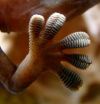(Press-News.org) PROVIDENCE, R.I. -- A catalyst made from a foamy form of copper has vastly different electrochemical properties from catalysts made with smooth copper in reactions involving carbon dioxide, a new study shows. The research, by scientists in Brown University's Center for the Capture and Conversion of CO2, suggests that copper foams could provide a new way of converting excess CO2 into useful industrial chemicals.
The research is published in the journal ACS Catalysis.
As levels of carbon dioxide in the atmosphere continue to rise, researchers are looking for ways to make use of it. One approach is to capture CO2 emitted from power plants and other facilities and use it as a carbon source to make industrial chemicals, most of which are currently made from fossil fuels. The problem is that CO2 is extremely stable, and reducing it to a reactive and useful form isn't easy.
"Copper has been studied for a long time as an electrocatalyst for CO2 reduction, and it's the only metal shown to be able to reduce CO2 to useful hydrocarbons," said Tayhas Palmore, professor of engineering and senior author of the new research. "There was some indication that if you roughen the surface of planar copper, it would create more active sites for reactions with CO2."
Copper foam, which has been developed only in the last few years, provided the surface roughness that Palmore and her colleagues were looking for. The foams are made by depositing copper on a surface in the presence of hydrogen and a strong electric current. Hydrogen bubbles cause the copper to be deposited in an arrangement of sponge-like pores and channels of varying sizes.
After depositing copper foams on an electrode, the researchers set up experiments to see what kinds of products would be produced in an electrochemical reaction with CO2 in water. The experiments were performed by Sujat Sen and Dan Liu, graduate students in chemistry working in Palmore's lab at Brown's School of Engineering.
The experiments showed that the copper foam converted CO2 into formic acid — a compound often used as a feedstock for microbes that produce biofuels — at a much greater efficiency than planar copper. The reaction also produced small amounts of propylene, a useful hydrocarbon that's never been reported before in reactions involving copper.
"The product distribution was unique and very different from what had been reported with planar electrodes, which was a surprise," Palmore said. "We've identified another parameter to consider in the electroreduction of CO2. It's not just the kind of metal that's responsible for the direction this chemistry goes, but also the architecture of the catalyst."
Now that it's clear that architecture matters, Palmore and her colleagues are working to see what happens when that architecture is tweaked. It's likely, she says, that pores of different depths or diameters will produce different compounds from a CO2 feedstock. Ultimately, it might be possible to tune the copper foam toward a specific desired compound.
Palmore said she's amazed by the fact that there's still more to be learned about copper.
"People have studied electrocatalysis with copper for a couple decades now," she said. "It's remarkable that we can still make alterations to it that affect what's produced."
The work in the study is part of a larger effort by Brown's Center for the Capture and Conversion of CO2. The Center, funded by the National Science Foundation, is exploring a variety of catalysts that can convert CO2 into usable forms of carbon.
"The goal is to find ways to produce some of the world's largest-volume chemicals from a sustainable carbon source that the Earth not only has in excess but urgently needs to reduce," said Palmore, who leads the center. "This is a way for us as scientists to begin thinking of how we produce industrial chemicals in more sustainable ways and control costs at the same time. The cost of commodity chemicals is going nowhere but up as long as production is dependent on fossil fuels."
INFORMATION:
The Center for Capture and Conversion of CO2 is a Center for Chemical Innovation funded by the National Science Foundation (CHE-1240020).
Brown University has a fiber link television studio available for domestic and international live and taped interviews, and maintains an ISDN line for radio interviews. For more information, call (401) 863-2476.
Copper foam turns carbon dioxide into useful chemicals
2014-08-12
ELSE PRESS RELEASES FROM THIS DATE:
Geckos use toe hairs to turn stickiness on/off
2014-08-12
WASHINGTON D.C. Aug. 12, 2014 -- If you've ever spent any time watching a gecko, you may have wondered about their uncanny ability to adhere to any surface -- including upside down on ceilings. It turns out the little lizards can turn the "stickiness" of toe hairs on the bottom of their feet on and off, which enables them to run at great speeds or even cling to ceilings without expending much energy.
In the Journal of Applied Physics, from AIP Publishing, Oregon State University (OSU) researchers describe their work exploring the subtleties of geckos' adhesion system ...
No excess baggage: Antarctic insect's genome, newly sequenced, is smallest to date
2014-08-12
COLUMBUS, Ohio – Scientists who sequenced the genome of the Antarctic midge suspect the genome's small size – the smallest in insects described to date – can probably be explained by the midge's adaptation to its extreme living environment.
The midge is a small, wingless fly that spends most of its two-year larval stage frozen in the Antarctic ice. Upon adulthood, the insects spend seven to 10 days mating and laying eggs, and then they die.
Its genome contains only 99 million base pairs of nucleotides, making it smaller than other tiny reported genomes for the body ...
Scientists discover the miracle of how geckos move, cling to ceilings
2014-08-12
CORVALLIS, Ore. – Researchers at Oregon State University have developed a model that explains how geckos, as well as spiders and some insects, can run up and down walls, cling to ceilings, and seemingly defy gravity with such effortless grace.
The solution, outlined today in the Journal of Applied Physics, is a remarkable mechanism in the toes of geckos that use tiny, branched hairs called "seta" that can instantly turn their stickiness on and off, and even "unstick" their feet without using any energy.
These extraordinary hairs contribute to the ability of geckos to ...
WSU researcher sees survival story in Antarctic fly's small genome
2014-08-12
PULLMAN, Wash.—Few animals can boast of being as tough as the Antarctic midge. Its larvae develop over not one but two Antarctic winters, losing nearly half their body mass each time. It endures high winds, salt, and intense ultraviolet radiation. As an adult, the midge gets by without wings and lives for only a week or so before starting its life cycle all over again.
And as Joanna Kelley has learned, it does this with the smallest insect genome sequenced so far.
"It's tiny," said Kelley, a Washington State University assistant professor, who recently sequenced and analyzed ...
Transgender relationships undermined by stigma
2014-08-12
PROVIDENCE, R.I. — Researchers who looked at the impact of discrimination, poverty and stigma on the mental health and relationship quality of transgender women and their male romantic partners found that social and economic marginalization not only takes a psychological toll on each person individually but also appears to undermine them as a couple.
It is difficult to be a transgender woman in the United States. Prior research has shown that they generally face high risks of depression, financial hardship, and discrimination, said study lead author Kristi Gamarel, a ...
Majority of Quebec children placed in out-of-home care are reunited with their family
2014-08-12
The majority of children in Quebec's youth protection system who are placed in out-of-home care (family foster care, or in a group or rehabilitation centre) are reunited with their "natural" families within 6 months, according to a study led by Professor Tonino Esposito of University of Montreal's School of Social Work. However, younger children, specifically those aged 2 to 5 years old at initial placement, have the lowest likelihood of returning to live with their natural families over time. "All placed children, irrespective of age, are less likely to return to live ...
Scared of crime? Good.
2014-08-12
EAST LANSING, Mich. -- In the past half-century, fear of crime in the United States has fueled "white flight" from big cities, become known as a quality of life issue and prompted scholars and law enforcement experts to address ways of reducing this fear.
But a study by a Michigan State University criminologist challenges this longstanding theory by arguing that a healthy fear of crime is, in fact, a good thing.
The study, published online in the journal Justice Quarterly, suggests adolescents who are more fearful of crime are less apt to become victims and offenders ...
ADHD, substance abuse and conduct disorder develop from the same neurocognitive deficits
2014-08-12
This news release is available in French. Researchers at the University of Montreal and CHU Sainte-Justine Research Centre have traced the origins of ADHD, substance abuse and conduct disorder, and found that they develop from the same neurocognitive deficits, which in turn explains why they often occur together. "Psychopathology exists on multiple continua of brain function. Some of these dimensions contribute to a multitude of problems, others contribute to specific problems. Together, they explain patterns of comorbidity such as why ADHD and conduct problems co-occur ...
Loss of eastern hemlock affects peak flows after extreme storm events
2014-08-12
The loss of eastern hemlock could affect water yield and storm flow from forest watersheds in the southern Appalachians, according to a new study by U.S. Forest Service scientists at the Coweeta Hydrologic Laboratory (Coweeta) located in Otto, North Carolina. The article was just published online in the journal Ecohydrology.
"Eastern hemlock trees have died throughout much of their range due to the hemlock woolly adelgid, an exotic invasive insect," said Steven Brantley, a post-doctoral researcher at Coweeta and lead author of the paper. "Though this insect has decimated ...
Graphene-based planar micro-supercapacitors for on-chip energy storage
2014-08-12
The rapid development of miniaturized portable electronic devices, such as micro-electromechanical systems, microrobots and implantable medical devices, has stimulated intense demand for micro-scale power sources. Although miniaturized micro-batteries that store energy by redox reactions provide the most frequently used micro-power source for current portable electronics on chip, their limited lifetime (hundreds or thousands of cycles) and low power density rule out applications that require high power over a short timeframe.
Micro-supercapacitors (MSCs) with a short ...






